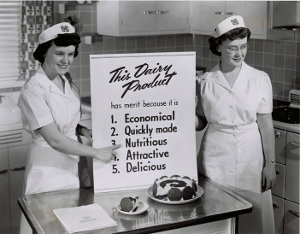![]()
Find out why our Government wanted us to “eat the carp,” “share our meat,” and “know our onions”
Eat more protein and fewer carbohydrates. These familiar recommendations came from Wilbur Olin Atwater in the 1890s. Atwater conducted the first federally funded nutrition research in the United States. His seminal studies contributed to the growing awareness of the varying amount of energy in foods. Prior to Atwater, most Americans considered food to be food. It didn’t matter what you ate, only how much. When Atwater’s findings were translated for consumers in 1916, the food guide was born. The USDA hired practitioners of the fledgling field of home economics to write these guides and lead nutrition programs through the Cooperative Extension Service.
Eschewing the “pinch of this, dab of that” tradition, home economists’ scientific approach to cooking made it easier to quantify the nutritional values of their recipes. During World Wars I and II, nutrition became not just a matter of public health, but of national security. To provide adequate nutrients for soldiers and civilians, the Government ramped up its nutrition education programs.
With certain foods in scarce supply, the understanding of food substitutes, like beans for meat, was critical. In his crusade to improve the nutritional quality of meals produced in American kitchens, Uncle Sam has funded groundbreaking research, deployed an army of home economists into the kitchens and classrooms of America, and plastered public spaces with pie charts and pyramids. Pitted against cultural traditions, advertising, and socioeconomic forces, the quest to change American eating habits has been an uphill battle.
